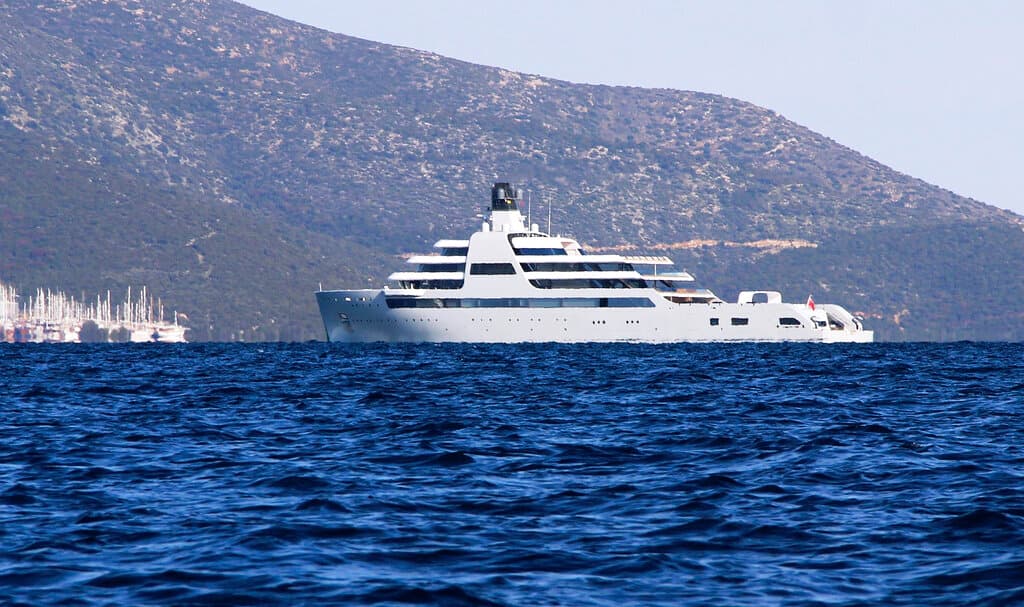Of the Sea and the Foundering Russian War Effort in Ukraine
Will the crackdown on Melnichenko and his ilk really alter the equation in Ukraine?

ATHENS — One was sabotaged, another was seized, and a third was blown to smithereens: Could the fates of three ships, though of vastly different pedigree and purpose, offer clues as to the direction of Vladimir Putin’s war on Ukraine?
To start, there’s the superyacht that a Ukrainian sailor tried to sink in Spain. Only four days after Russian troops invaded Ukraine, the 457-foot-long yacht Lady Anastasia was floating pretty in an upscale marina at the Spanish island of Mallorca. The vessel is purportedly owned by Alexander Mikheev, the 61-year-old CEO of Rosoboronexport, the weapons export arm of Russia’s state-owned defense conglomerate Rostec.
A Ukrainian crew member tasked with the yacht’s maintenance, Taras Ostapchuk, had known of his employer’s activities for years, but he told the Associated Press that when he saw images carried on an online newscast of a Russian missile striking a house resembling his own in Kiev, it flipped a switch in his head.
The arms produced by its owner are “now being used against my own people,” Mr. Ostapchuk said, and sinking Mr. Mikheev’s aquatic toy was to be an unapologetic act of revenge. Mr. Ostapchuk opened two hatches in an attempt to flood the yacht, but according to his court deposition the sailor did act to avoid polluting or causing harm to others by closing the yacht’s fuel valves and alerting his fellow crew members, all of whom happen to be Ukrainians.
An intervention from Spanish officers prevented Lady Anastasia from capsizing and a judge in Mallorca, where Mr. Ostapchuk was detained following his arrest, apparently showed him leniency because the would-be saboteur was last seen boarding a flight for Kiev to join the fight against Russian forces.
The episode underscores that there is a lot of anger among Ukrainians over Russia’s warmongering, and there is much more fight in them than Moscow banked on — as demonstrated by weeks of unexpectedly effective Ukrainian counter-offensives against Russian forces in the suburbs of Kiev, elsewhere around the country, in the skies above it, and now, though in limited scope, at sea. Not the Mediterranean (back to that one in a moment), but the Black Sea.
That is where Ukraine claimed to have struck the Russian Navy’s landing ship Orsk at the Russian-occupied port of Berdyansk last week, an attack that has been confirmed by the U.S. Department of Defense. The destruction of an Alligator-class landing ship that was ferrying Russian soldiers to the besieged city of Mariupol nearby was no small feat and a significant boost of morale to the Ukrainian armed forces.
Strategically, however, it is less significant. For one thing, despite some understandable cheerleading in the Western press for a Ukrainian hit on an invading Russian vessel, a ship like the Orsk is not by a long shot the deadliest shark in the Russian tank. According to the Pentagon, Russia currently has 22 warships in the Black Sea — 15 are surface combatant ships and the remainder are amphibious ships like the Orsk. Two Ropucha-class landing ships have reportedly already left Berdyansk for the port of Sevastopol in Russian-occupied Crimea.
A senior American defense official told U.S. Naval Institute News that the Pentagon has seen the Russians “move into the Sea of Azov to conduct an amphibious assault, to try to resupply their efforts on Mariupol. We have not seen them move on Odessa.” That official added, “But clearly they could reach parts of the Donbas from the Sea of Azov if they wanted to. They could absolutely use some of their surface power — particularly missiles — if they wanted to.”
Ukraine does have a small navy, which was based in the Crimean port of Sevastopol until Russia seized Crimea in 2014. When it did, Moscow not only nabbed a number of Ukrainian ships but several naval officers who defected to Russia. Earlier this month, Russian forces captured up to a dozen ships in Berdyansk.
USNI reported that an unspecified number of Russian landing ships from the Pacific Fleet are en route to the Black Sea. Amid all this buildup, the loss of one ship amounts to, well, the loss of one ship. And while it is not clear whether the Ukrainians used a missile or drone to take out the Orsk, it does seem like the attack would have come from the land and not the sea, where Russia will continue to have an overwhelming numerical advantage.
Regardless, superyachts are always more fun than amphibious military supply ships — unless the superyacht you happen to own was just seized by the Italian police. That is what happened earlier this month to Russian billionaire Andrey Melnichenko’s misleadingly named Sailing Yacht A, which was confiscated by Italian authorities at Trieste and apparently hasn’t disembarked since.
The name is a slight misnomer because if Mr. Melnichenko’s yacht is not the world’s biggest, it is arguably the most spectacular: a sail-assisted motor yacht that soars 469 feet high, its interior was designed by Philippe Starck and its stern descends amphitheatrically to sea level in three interconnected sections. The futuristic, German-built über-boat is fit for a James Bond villain of the highest order. Not that the two yachts now docked in Turkey that belong to the sanctioned Russian-Israeli oligarch Roman Abramovich are dinghies by any stretch.
Yet Mr. Melnichenko is not like Mr. Abramovich or many other Russian oligarchs, most of whom, it is widely believed if not always easily proven, obtained the kernel of their fortunes from misbegotten monies as Russia transitioned from communism to capital… er, kleptocracy. According to a report in the Emirates’ National News, Mr. Melnichenko founded MDM Bank but in the 1990s was too young to take part in the privatizations under President Yeltsin that handed the choicest assets of a former superpower to a group of businessmen who would become known as the oligarchs. Instead he bought up distressed coal and fertilizer assets, and his fortune in 2021 was estimated by Forbes to be $18 billion, making him Russia’s eighth-richest man.
So it is conceivable that Mr. Melnichenko did not buy his oversized sea toy with black money. Still, the EU slapped sanctions on him because it said his attendance at a Kremlin meeting with Vladimir Putin and 36 businessmen organized by the Russian Union of Industrialists and Entrepreneurs showed he was “one of the leading businesspersons involved in economic sectors” in Russia.
His spokesman said Mr. Melnichenko is disputing the sanctions and has “no relation to the tragic events in Ukraine. He has no political affiliations.”
Will the crackdown on Mr. Melnichenko and his ilk really alter the equation in Ukraine? The president of the Institute of Modern Russia, Pavel Khodorkovsky, recently told the Washington Post’s Dan Zak: “I’m seeing the headlines: $40 billion or $60 billion of wealth wiped out from the Russian elite — I really don’t care,” because “it won’t change Putin’s mind.”
Treasury Secretary Yellen and Attorney General Garland on Wednesday for the first time convened a multilateral task force known as REPO, one of several new efforts designed to “seize and freeze” the giant floating limousines, penthouses, and other pricey assets of the Russian elites, AP reports. The group is now looking into 50 individuals, but the initiative faces several challenges, including varying laws across countries that could make legal discovery difficult and the risk of penalizing innocent people whose property may be tied up in an oligarch’s seized assets.
Furthermore, investigations can drag on for years. Countries have been split in two in much less time than that.

